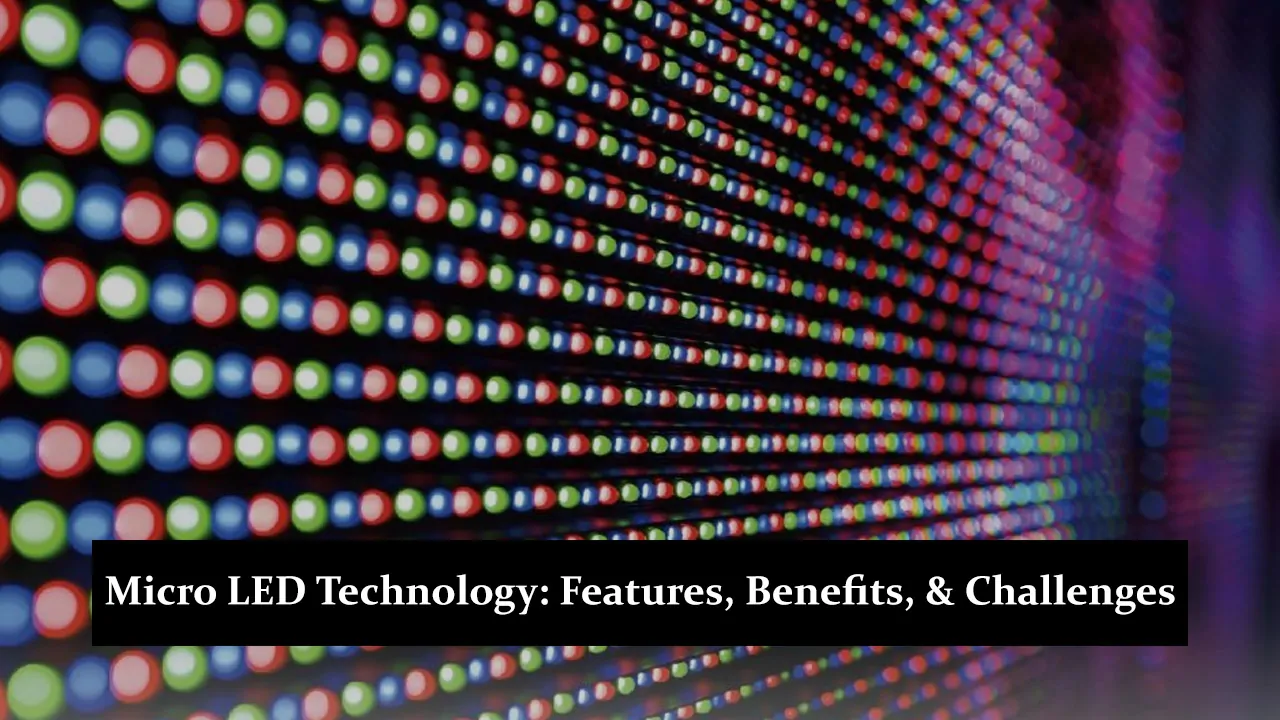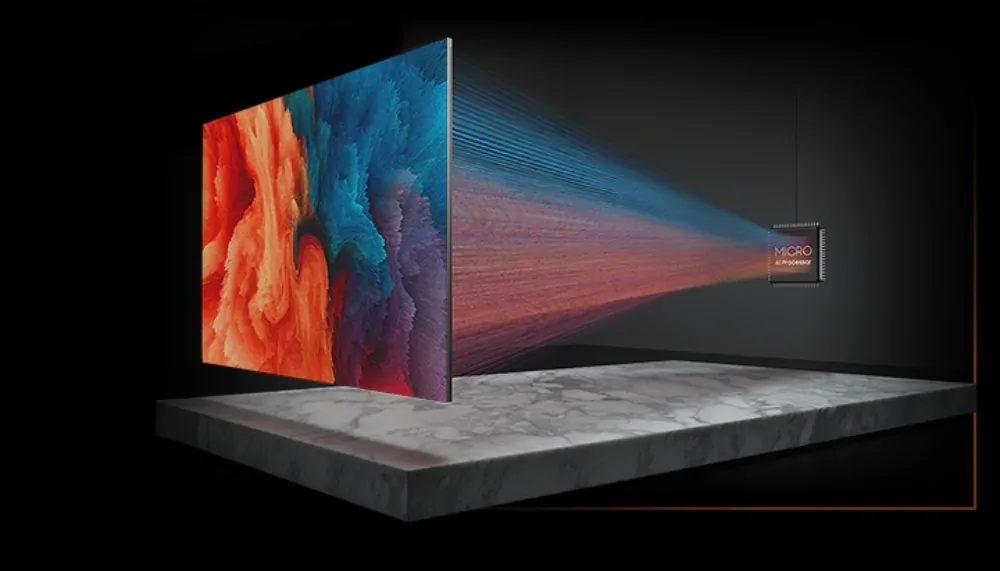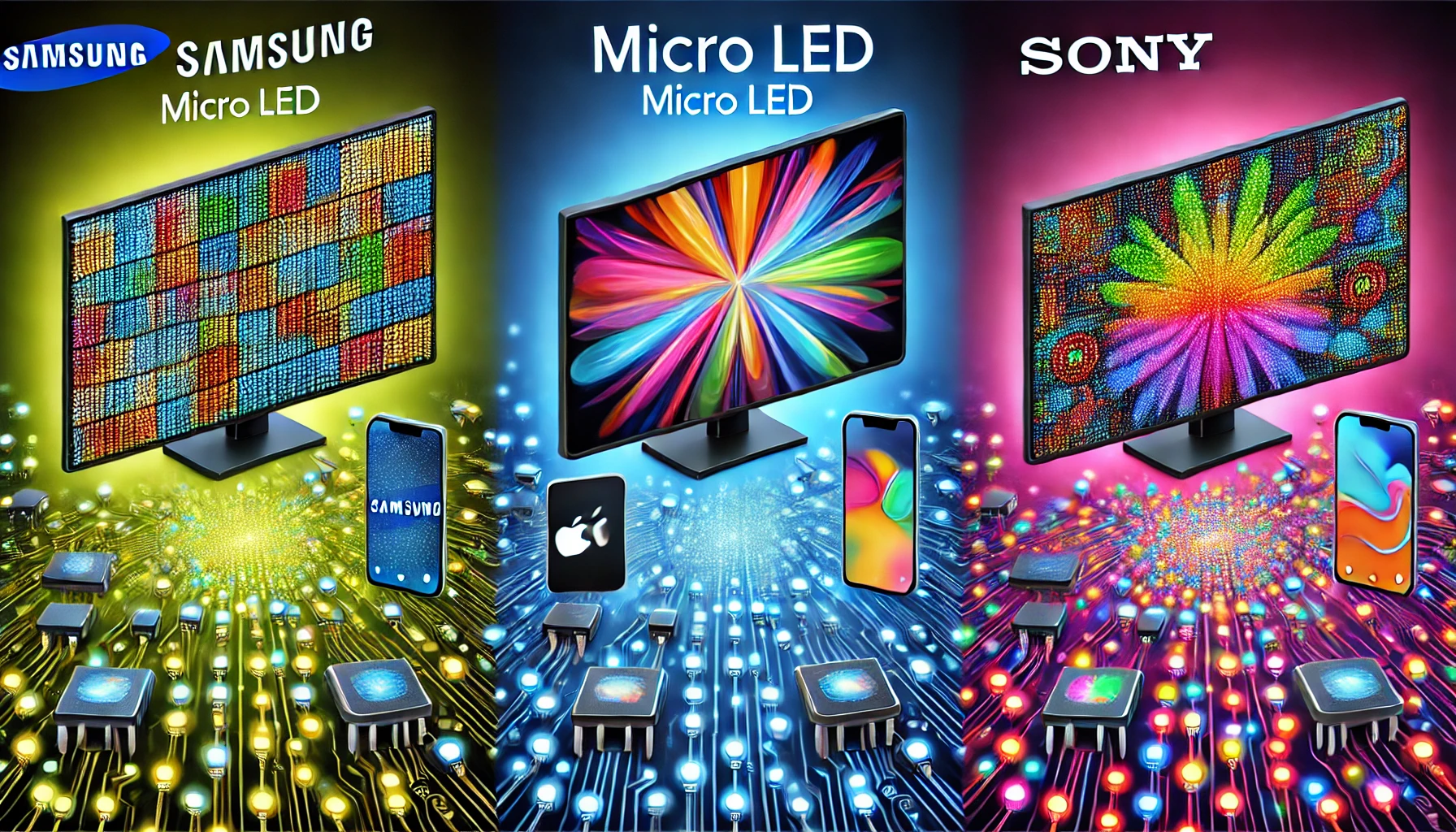Micro LED is a new display technology that uses tiny LED lights to create sharp, bright images on screens. It’s becoming popular because it offers better picture quality, energy efficiency, and longer life than older technologies like LCD and OLED. Micro LED is gaining attention as more people want high-quality displays for their devices. This blog will explore how Micro LED works, why it’s important, and where it’s being used today. Let’s dive into this exciting technology and see what the future holds for Micro LED.
What is Micro LED?
Micro LED is a cutting-edge display technology that uses tiny, light-emitting diodes (LEDs) to create images. Each pixel in a Micro LED screen comprises these tiny LEDs, which light up individually to show different colours and brightness levels. Because each pixel works independently, Micro LED displays can produce more vivid colours, deeper blacks, and much higher brightness. This technology also allows for sharper images and better performance than older screens like LCD and OLED.
Key Features and Advantages of Micro LED
Superior Brightness
Micro LED displays are known for their outstanding brightness. Each tiny LED emits light, meaning these screens can reach higher brightness levels than traditional displays. This makes Micro LED screens perfect for indoor and outdoor environments, even in bright sunlight. Whether using a phone or watching a large screen, the images remain clear and sharp. This superior brightness is one of the key reasons Micro LED is gaining popularity.
Higher Contrast Ratios
Micro LED screens provide much higher contrast ratios compared to older technologies like LCD and OLED. Since each pixel can be individually turned on or off, it creates deep blacks and brilliant whites. This ability to show true blacks and bright whites makes the images on the screen look more realistic and vivid. The higher contrast results in an improved viewing experience, whether watching movies, playing games, or using your device for work.
Better Energy Efficiency
One of the standout advantages of Micro LED is its energy efficiency. Since each LED in the display only uses power when turned on, Micro LED screens consume less energy than LCD and OLED displays. This is especially useful for devices like smartphones and wearables, where battery life is crucial. With less energy consumption, Micro LED displays can extend the battery life of devices, making them more efficient for everyday use.
Faster Response Times
Micro LED technology offers incredibly fast response times, meaning pixels can change colour or brightness quickly. This is especially important for fast-paced content like action movies, sports, or gaming, where slow response times can cause blurring or ghosting. With Micro LED, images appear instantly, ensuring smooth motion and crisp visuals. This speed is ideal for high-performance devices like gaming monitors and high-end televisions.
Improved Lifespan and Durability
Micro LED displays are built to last longer than many other types of screens. The tiny LEDs are less prone to burn-in, a common problem in other display technologies like OLED. This durability means that Micro LED screens can maintain brightness and colour quality over many years. For consumer electronics or industrial displays, Micro LEDs’ longer lifespan and reliability make them a better long-term investment.
Scalability for Different Screen Sizes
One of the most versatile features of Micro LED is its scalability. This technology can be used to create displays of different sizes, from small screens like smartwatches to large panels used in TVs and even billboards. Because of this flexibility, Micro LED suits various industries, including consumer electronics, automotive, and digital signage. Its ability to maintain quality across various screen sizes makes it highly adaptable and future-proof.
Applications of Micro LED Technology
Consumer Electronics (TVs, Smartphones, Wearables)
Micro LED technology is adopted in consumer electronics like TVs, smartphones, and wearables. The superior brightness, energy efficiency, and long lifespan make it a perfect choice for high-end devices. Micro LED TVs offer clearer images and vibrant colours, while smartphones and smartwatches benefit from better battery life and brighter screens. This technology enhances the user experience by providing better visuals and performance across these devices.
Automotive Displays
In the automotive industry, Micro LED is used for next-generation vehicle displays. Its high brightness and fast response times make it ideal for dashboards, infotainment systems, and heads-up displays. With Micro LED, drivers get clearer information, even in direct sunlight or low-light conditions. The technology also supports curved and flexible screens, allowing car manufacturers to design sleek, futuristic interiors.
Commercial and Industrial Uses (Large-Scale Displays, Digital Signage)
Micro LED is entering commercial and industrial applications, especially for large-scale displays and digital signage. Its scalability allows it to be used for massive screens in public places like shopping malls, airports, and stadiums. These displays provide bright, high-resolution visuals that can be seen from a distance, making them ideal for advertising and information displays. Micro LED’s durability also makes it a reliable choice for 24/7 use in industrial environments.
Virtual Reality and Augmented Reality
Micro LED plays a crucial role in developing virtual reality (VR) and augmented reality (AR) devices. These applications require fast response times, high brightness, and lightweight screens, all of which Micro LED offers. With this technology, VR headsets can deliver more immersive experiences with sharper visuals and no motion blur. In AR, Micro LED’s ability to create clear images in varying lighting conditions makes it a strong candidate for future advancements in smart glasses and other wearable tech.
Micro LED vs. OLED vs. Mini LED
| Feature | Micro LED | OLED | Mini LED |
| Brightness | Extremely high, ideal for both indoor and outdoor use | High, but generally lower than Micro LED | High, better than OLED, but not as bright as Micro LED |
| Colour Accuracy | Excellent, with vivid colours and deep blacks | Excellent, known for perfect blacks and high contrast | Good, but slightly less accurate than OLED and Micro LED |
| Energy Efficiency | Very energy-efficient; only uses power when LEDs are on | Energy-efficient but can suffer from burn-in with static images | Energy-efficient but requires a more complex backlighting system |
| Response Time | Ultra-fast, ideal for high-speed applications like gaming | Fast, but slower than Micro LED | Fast, similar to OLED, but not as quick as Micro LED |
| Durability | Very durable, long lifespan with no burn-in risk | Prone to burn-in over time with static content | Durable, with less risk of burn-in than OLED but more components |
| Scalability | Highly scalable, suitable for small and large screens | Limited scalability, best for smaller to medium screens | Scalable, especially in larger displays like TVs |
| Advantages | Superior brightness, energy efficiency, and durability | Excellent colour accuracy, deep blacks, and flexibility | High brightness, good contrast, and cost-effective for large displays |
| Disadvantages | High production cost, complex manufacturing | Burn-in risk, lower brightness compared to Micro LED | More complex backlighting, slightly less accurate colours |
| Current Market Adoption | Emerging, used in high-end products like TVs and wearables | Widely adopted in smartphones, TVs, and premium devices | Common in large-screen TVs, increasing adoption in mid-range products |
Challenges in Micro LED Adoption
- Manufacturing Complexity: Producing Micro LED displays involves the precise placement of millions of tiny LEDs, making the manufacturing process highly complex and time-consuming. This requires advanced technology and equipment, which has yet to be widely available.
- High Production Costs: Micro LED displays are expensive to manufacture due to their complexity. The high costs make it difficult for companies to offer Micro LED products at affordable prices for mass consumers, limiting widespread adoption.
- Scalability Issues for Mass-Market Use: While Micro LED can be scaled for various screen sizes, producing these displays in large quantities for the mass market remains challenging. The difficulty in achieving high yields in production slows down the technology’s progress toward becoming mainstream.
Recent Developments in Micro LED
Key Manufacturers Working on Micro LED (Samsung, Apple, Sony, etc.)
Major tech companies like Samsung, Apple, and Sony are investing heavily in Micro LED technology. Samsung has been a leader in showcasing Micro LED TVs, while Apple is reportedly working on integrating the technology into its future devices, including the Apple Watch. Sony has also introduced large-scale Micro LED displays for commercial use, signalling the increasing interest of big players in this field.
Innovations in Production Techniques
Companies are developing new production techniques to address the challenges of manufacturing complexity and cost. These include advancements in chip miniaturisation, improved transfer processes for placing LEDs, and more efficient assembly methods. Future trends also point toward using flexible and transparent Micro LED screens, which could open up new possibilities for product designs, including foldable displays and smart glass applications.
Conclusion
Micro LED technology stands out for its superior brightness, energy efficiency, fast response times, and durability, making it a promising advancement in the display industry. While challenges like high production costs and manufacturing complexity remain, major companies actively work on innovations to overcome these barriers. As production becomes more efficient, we can expect Micro LED to become more accessible and revolutionise various industries. With its potential to enhance displays in consumer electronics, automotive, and even virtual reality, Micro LED is set to shape the future of display technology.
FAQs
What is Micro LED, and how does it differ from other technologies?
Micro LED is a display technology that uses tiny, individual LEDs to create each pixel on the screen. Unlike OLED, which uses organic materials to emit light, Micro LED uses inorganic materials, offering better brightness, energy efficiency, and a longer lifespan. It also outperforms LCD in terms of brightness and response time.
What are the main benefits of Micro LED?
Micro LED provides several advantages, including superior brightness, higher contrast ratios, better energy efficiency, faster response times, and improved durability. It also offers greater scalability, making it suitable for small devices and large-scale displays.
When can we expect Micro LED to be widely available?
While Micro LED is already available in high-end products like premium TVs and commercial displays, it is expected to become more widely accessible in the next few years. As production techniques improve and costs decrease, more consumer devices like smartphones and wearables will adopt the technology.







